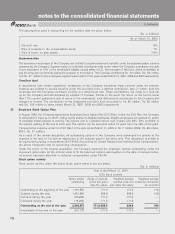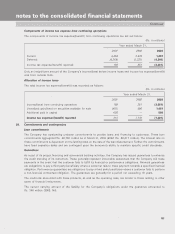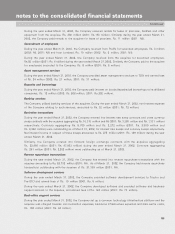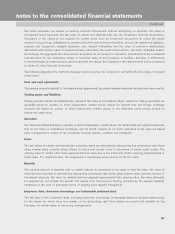ICICI Bank 2003 Annual Report Download - page 161
Download and view the complete annual report
Please find page 161 of the 2003 ICICI Bank annual report below. You can navigate through the pages in the report by either clicking on the pages listed below, or by using the keyword search tool below to find specific information within the annual report.
F97
Fair value estimates are based on existing financial instruments without attempting to estimate the value of
anticipated future business and the value of assets and liabilities that are not considered financial instruments.
Disclosure of fair values is not required for certain items such as investment accounted for under the equity
method of accounting, obligations for pension and other post-retirement benefits, income tax assets and liabilities,
property and equipment, prepaid expenses, core deposit intangibles and the value of customer relationships
associated with certain types of consumer loans, particularly the credit card portfolio, and other intangible assets.
Accordingly, the aggregate fair value amount presented do not purport to represent, and should not be considered
representative of, the underlying market or franchise value of the Company. In addition, because of differences
in methodologies and assumptions used to estimate fair values, the Company’s fair values should not be compared
to those of other financial institutions.
The following describes the methods and assumptions used by the Company in estimating the fair values of financial
instruments:
Cash and cash equivalents
The carrying amounts reported in the balance sheet approximate fair values because maturities are less than three months.
Trading assets and liabilities
Trading account assets and liabilities are carried at fair value in the balance sheet. Values for trading securities are
generally based on quoted, or other independent, market prices. Values for interest rate and foreign exchange
products are based on quoted, or other independent, market prices, or are estimated using pricing models or
discounted cash flows.
Securities
Fair values are based primarily on quoted, or other independent, market prices. For certain debt and equity investments
that do not trade on established exchanges, and for which markets do not exist, estimates of fair value are based
upon management’s review of the investee’s financial results, condition and prospects.
Loans
The fair values of certain commercial and consumer loans are estimated by discounting the contractual cash flows
using interest rates currently being offered for loans with similar terms to borrowers of similar credit quality. The
carrying value of certain other loans approximates fair value due to the short-term and/or repricing characteristics of
these loans. For impaired loans, the impairment is considered while arriving at the fair value.
Deposits
The carrying amount of deposits with no stated maturity is considered to be equal to their fair value. Fair value of
fixed-rate time deposits is estimated by discounting contractual cash flows using interest rates currently offered on
the deposit products. Fair value for variable-rate time deposits approximates their carrying value. Fair value estimates
for deposits do not include the benefit that results from the low-cost funding provided by the deposit liabilities
compared to the cost of alternative forms of funding (core deposit intangibles).
Long-term debt, short-term borrowings and redeemable preferred stock
The fair value of the Company’s debt, including short-term borrowings, is estimated based on quoted market prices
for the issues for which there is a market, or by discounting cash flows based on current rate available to the
Company for similar types of borrowing arrangements.
Continued
notes to the consolidated financial statements

















